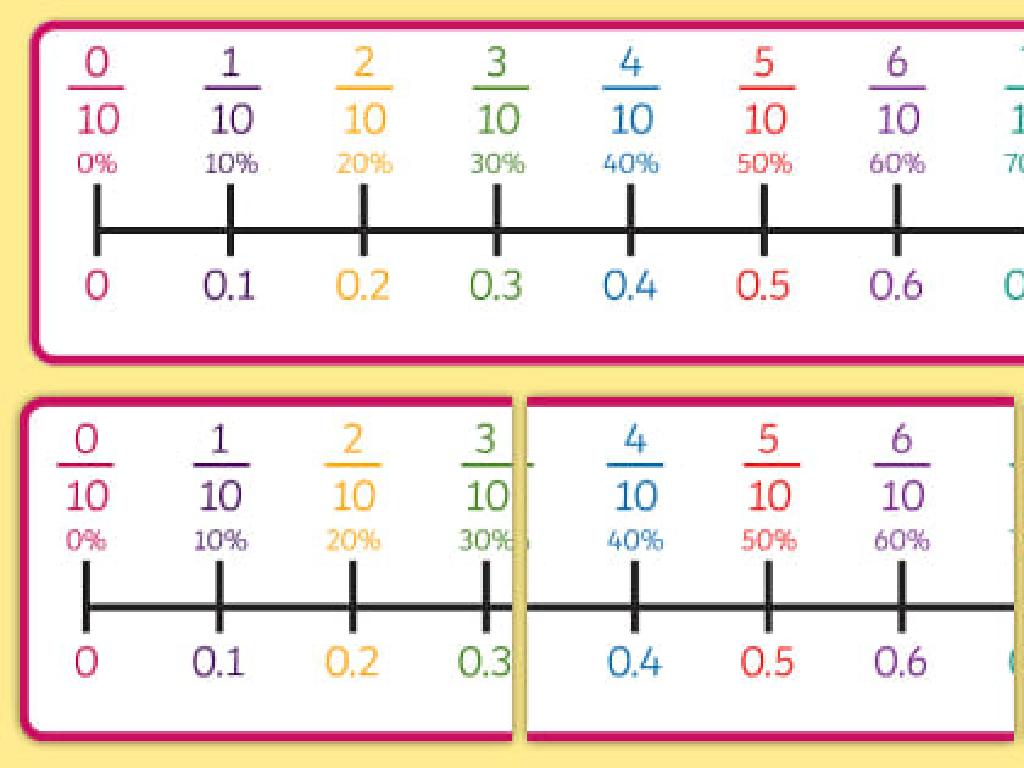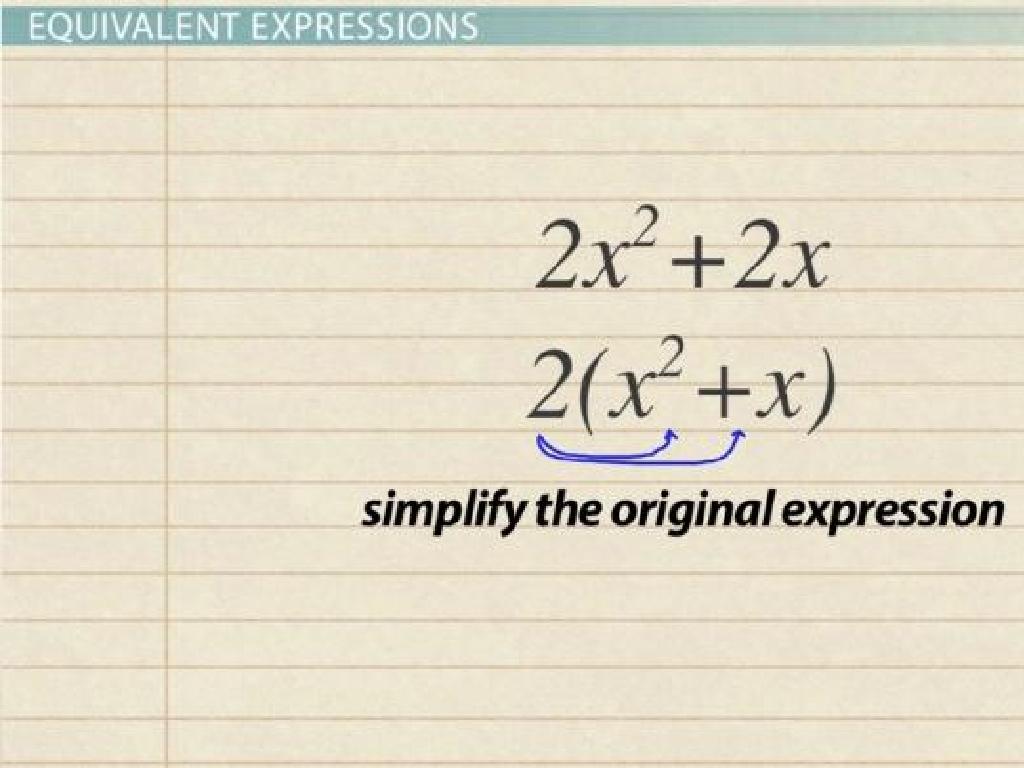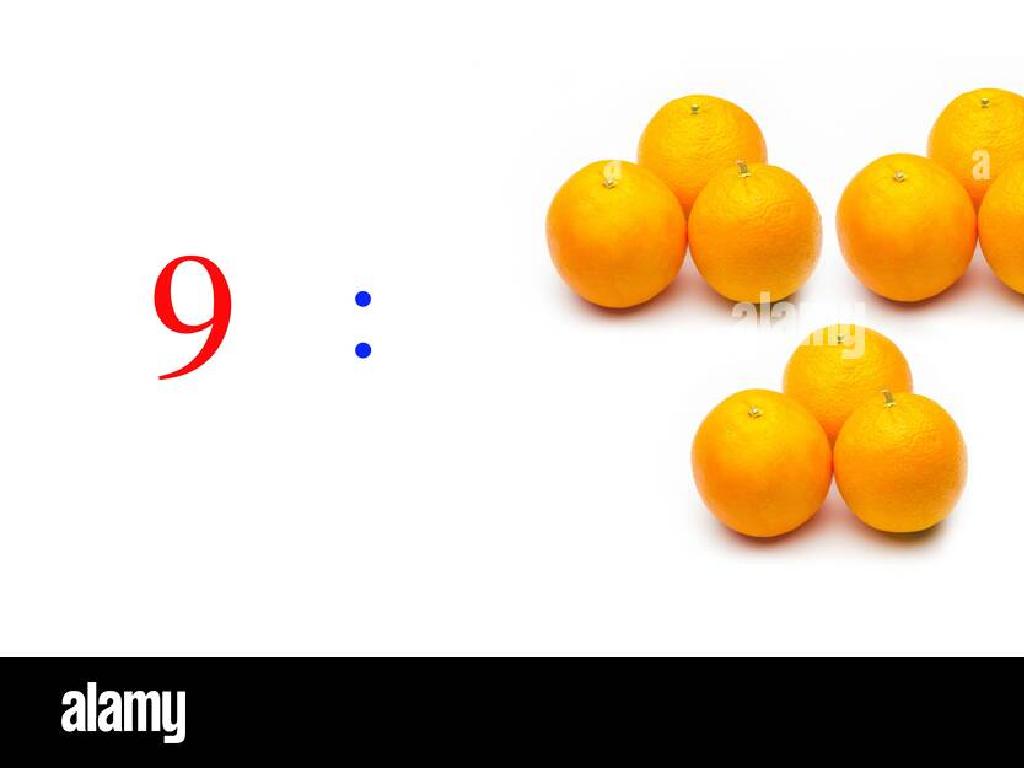Multiply 1-Digit Numbers By 2-Digit Numbers
Subject: Math
Grade: Fourth grade
Topic: Multiply By One-Digit Numbers
Please LOG IN to download the presentation. Access is available to registered users only.
View More Content
Welcome to Multiplication!
– Multiplication as repeated addition
– If you have 4 groups of 3, instead of adding 3+3+3+3, you can multiply 4×3.
– Power of multiplication in math
– Multiplication helps us solve problems quickly without long addition.
– Steps to multiply 1-digit by 2-digit
– Write the 2-digit number above the 1-digit number and multiply each digit.
– Practice with examples
– Example: 12 x 3. Multiply 2 x 3 = 6, then 1 x 3 = 3, and put them together to get 36.
|
This slide introduces students to the concept of multiplication as a form of repeated addition, which is a foundational skill in mathematics. Emphasize the efficiency of multiplication over addition for larger quantities. Walk through the steps of multiplying a 1-digit number by a 2-digit number, ensuring to align numbers correctly and add the results. Provide several examples and encourage students to work through them, reinforcing the process. This will prepare them for more complex multiplication and develop their arithmetic skills.
Review: Multiplication Basics
– Recap multiplication facts
– Multiplication as repeated addition
– Multiplying is like adding a number to itself several times
– Example: 3 x 4 = 12
– 3 groups of 4 equals 12
|
Begin the lesson with a quick review of multiplication facts to refresh the students’ memory. Emphasize that multiplication is a shortcut for repeated addition. For example, 3 multiplied by 4 can be thought of as adding the number 4 together three times (4 + 4 + 4), which equals 12. Use simple examples that the students are familiar with to illustrate this point. This foundational understanding will help them grasp the concept of multiplying 1-digit numbers by 2-digit numbers in the following lessons. Encourage students to think of multiplication as groups of numbers to make it more intuitive.
Multiplying 1-Digit by 2-Digit Numbers
– Understand the multiplication steps
– Example: Multiplying 4 x 12
– 4 times 12 is like 4 groups of 12
– Multiply 1-digit with each digit of 2-digit
– First, 4 x 2 = 8, then 4 x 1 = 4 (place a zero under the 8)
– Add the results for the final answer
– 4 x 2 = 8 and 4 x 10 = 40, add them to get 48
|
This slide introduces students to the concept of multiplying a 1-digit number by a 2-digit number. Start by explaining the steps involved in the process. Use the example 4 x 12 to demonstrate the method: multiply the 1-digit number by each digit of the 2-digit number separately, then combine the results. Emphasize the importance of place value by showing that when you multiply by the tens place, you’re actually multiplying by 10. Encourage students to practice with different numbers and to check their work by using addition. Provide several examples and possibly a group activity where students can work together to solve similar multiplication problems.
Let’s Practice Together: Multiplication
– Class example: 4 x 23
– Discuss each multiplication step
– Break down 4 x 23 into 4 x 20 and 4 x 3
– Solve the problem step by step
– Add the results of 4 x 20 and 4 x 3 to find the total
– Review and check our answer
– Ensure our multiplication and addition are correct
|
This slide is an interactive class activity designed to practice multiplying a 1-digit number by a 2-digit number. Start by presenting the problem 4 x 23 to the class. Break down the steps by first multiplying 4 by the tens place (20), then by the ones place (3), and finally adding the two products together. Encourage students to participate in each step, discussing the process and reasoning behind it. After solving, review the steps taken and verify the answer with the class. This exercise will help reinforce the concept of multiplication and build confidence in solving similar problems. Prepare to provide additional examples if time allows and ensure that students are comfortable with the process before moving on.
Try It Yourself: Multiplication Practice
– Solve 5 x 34 on scratch paper
– Break down the problem step-by-step
– First, multiply 5 by 4, then 5 by 30
– Understand each part of the multiplication
– Recognize 5 x 4 is 20 and 5 x 30 is 150
– Explain your solution process
– Share how you added 150 and 20 to get 170
|
This slide is for a class activity focused on individual practice of multiplying a 1-digit number by a 2-digit number. Students should use scratch paper to work through the problem 5 x 34. Encourage them to break the problem into smaller parts, multiplying 5 by 4 (the ones place) and then 5 by 30 (the tens place), before adding the two products together. This exercise will help solidify their understanding of the multiplication process and the concept of place value. After solving, students should be ready to explain the steps they took to reach the answer, promoting their communication skills and reinforcing their learning. For the teacher: Prepare to walk around the classroom to assist students who may struggle and to affirm correct understanding. Have a few students share their methods with the class to demonstrate different approaches to the same problem.
Common Mistakes in Multiplication
– Remember to carry over numbers
– When a product exceeds 9, carry over to the next place value.
– Keep the multiplication order correct
– Always multiply each digit in the correct order to avoid errors.
– Review a sample mistake together
– Let’s correct a mixed-up multiplication example as a class.
– Practice makes perfect
|
This slide aims to highlight frequent errors students make while multiplying 1-digit numbers by 2-digit numbers. Emphasize the importance of carrying over when a product is 10 or more, which is a common oversight. Stress the correct order of multiplication, starting from the rightmost digit. Walk through a sample problem where these mistakes have occurred and correct it step by step with the class. Encourage students to practice regularly, as this will help them avoid these mistakes and become more confident in their multiplication skills.
Multiplication Games: Practice and Fun!
– Engage with an interactive multiplication game
– Pair up for ‘Multiplication Match’
– Find a partner and get a set of multiplication cards
– Solve multiplication problems together
– Work as a team to solve and learn from each problem
– Check each other’s answers
– Help each other and ensure accuracy in calculations
|
This slide introduces a fun and interactive way to reinforce the concept of multiplying 1-digit numbers by 2-digit numbers. The interactive multiplication game should be designed to provide immediate feedback and allow students to practice multiple times. ‘Multiplication Match’ is a peer activity where students pair up, each pair receives a set of multiplication problem cards and corresponding answer cards. They take turns drawing a problem card, solving it, and then finding the matching answer card. This encourages collaboration and peer learning. Teachers should monitor the pairs to provide help as needed and ensure that students are engaged and correctly checking each other’s work. Possible variations of the game could include timed challenges, ‘beat the clock’, or a ‘multiplication scavenger hunt’ where students find and solve problems around the classroom.
Class Activity: Multiplication Relay Race
– Form teams for a relay race
– Solve a multiplication problem each
– Each student tackles one 1-digit by 2-digit multiplication
– Pass to the next teammate
– First team with all correct wins!
|
This activity is designed to encourage teamwork and reinforce the concept of multiplying 1-digit numbers by 2-digit numbers. Divide the class into small groups, ensuring an equal number of students per team. Provide each team with a set of multiplication problems. Each student solves one problem before passing the baton to the next team member. The race continues until one team completes all problems correctly. This activity promotes a fun, competitive environment while practicing multiplication skills. Possible variations include a mix of difficulty levels, timed rounds, or a ‘sudden death’ round where teams compete head-to-head on the same problem.
Homework and Wrap-Up: Multiplication Mastery
– Practice multiplication for homework
– Review today’s multiplication lesson
– We learned to multiply 1-digit by 2-digit numbers
– Engage with fun home activities
– Use games or flashcards to make practice enjoyable
– Keep practicing for skill improvement
|
As we conclude today’s lesson on multiplying 1-digit numbers by 2-digit numbers, assign students multiplication problems to reinforce their skills. Summarize the key points of the lesson, ensuring they understand the steps involved in the multiplication process. Encourage them to practice at home using fun methods such as multiplication games or flashcards to keep them engaged. Remind them that consistent practice is essential for improving their multiplication skills. For the next class, be prepared to discuss the homework, answer any questions, and possibly conduct a quick quiz to assess their understanding.






